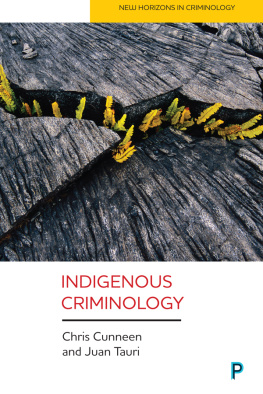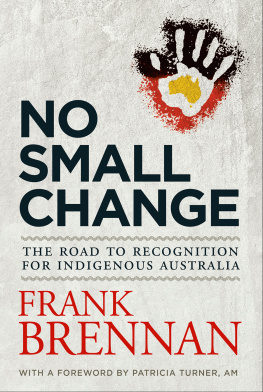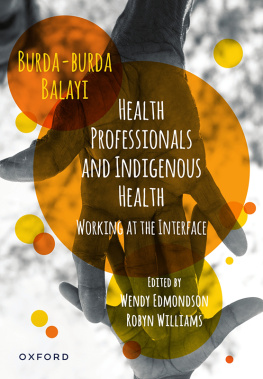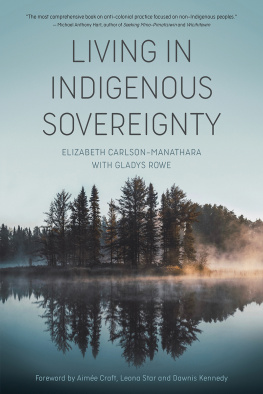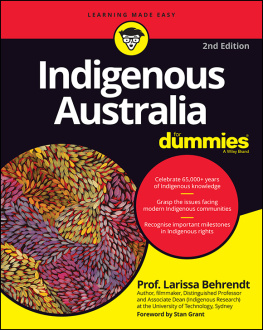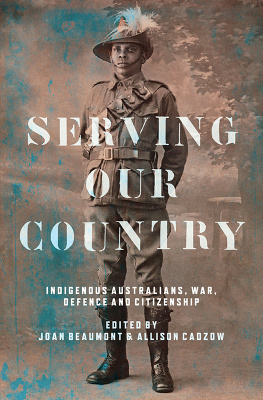First published in 2011
by Aboriginal Studies Press
Patrick Sullivan 2011
All rights reserved. No part of this book may
be reproduced or transmitted in any form or by
any means, electronic or mechanical, including
photocopying, recording or by any information storage
and retrieval system, without prior permission in
writing from the publisher. The Australian Copyright
Act 1968 (the Act) allows a maximum of one chapter
or 10 per cent of this book, whichever is the greater,
to be photocopied by any educational institution for
its education purposes provided that the educational
institution (or body that administers it) has given a
remuneration notice to Copyright Agency Limited
(CAL) under the Act.
Aboriginal Studies Press
is the publishing arm of the
Australian Institute of Aboriginal
and Torres Strait Islander Studies.
GPO Box 553, Canberra, ACT 2601
Phone: (61 2) 6246 1183
Fax: (61 2) 6261 4288
Email:
Web: www.aiatsis.gov.au/asp/welcome.html
National Library of Australia
Cataloguing-In-Publication data:
Author: Sullivan, Patrick (Patrick John)
Title: Belonging together: dealing with the politics
of disenchantment in Australian Indigenous policy/
Patrick Sullivan.
ISBN: 9780855757809 (pbk.)
ISBN: 9780855757830 (Ebook PDF)
ISBN: 9780855757861 (ePub)
Notes: Includes index.
Subjects: Aboriginal Australians Social
conditions Australia. Aboriginal Australians
Government policy 21st century. Immigrants
Cultural assimilation Australia. Australia
Government policy.
Dewey Number: 305.89915
Printed in Australia by SOS Print Group
Front cover photograph courtesy Dean Mathews
Nyamba Buru Yawuru Ltd.
ACKNOWLEDGMENTS
I have been a Research Fellow at the Australian Institute of Aboriginal and Torres Strait Islander Studies (AIATSIS) during the period that this book was written. I am grateful for the opportunity AIATSIS has given me to explore Aboriginal policy issues. I am also grateful to the National Centre for Indigenous Studies at the Australian National University and the Centre for Indigenous Studies at Notre Dame University (Broome) for giving me space to concentrate on the writing task on several occasions. Particular thanks go to Professor Mick Dodson, Steve Kinnane and Bruce Gorring. I have benefitted from the thoughtful comments of Mike Dillon on on the importance of the Aboriginal community sector. The fraught period of final manuscript preparation was made considerably easier by the meticulous professionalism of my editor, Cathy Edmonds. Parts of some of these chapters have previously been published in Telescope, the Journal of the National Centre for Public Administration Quebec (Chapter One); Oceania (Chapter Two); Ngayi: Talk the Law, University of Technology Sydney (Chapter Three); The Desert Knowledge Cooperative Research Centre Working Paper series (chapters four, seven and elsewhere); the International Journal of Public Sector Management (Chapter Five); and Critical Perspectives on International Business (Chapter Six). They have been revised for this book.
PREFACE
This book was written during a period of deep change in Aboriginal affairs administration not seen in Australia for four decades.
At the time of writing, the public at large is disenchanted with Aboriginal Australia, particularly the corporate expressions of Aboriginal life in representative organisations. Part of this disenchantment is the perception that Aboriginal organisations have failed their communities as expressions of self-determination or self-management, and part of it is because they have done too well imposing Aboriginal needs and desires on the wider population. Informing both perceptions is the idea that Aboriginal people and their organisations are somehow out there rather here with us. They may be viewed as a part of Australia, perhaps a significant part of its history, but not an important element of Australian self-identification, much less a significant component of the Commonwealth, except as a drain on its public funds.
This book attempts to move beyond the neo-assimilationist position of the governments of the previous decade in Australia and the radical minority-rights approach against which it was formulated. A necessary part of this is a greater integration of white Australia with Aboriginal Australia, a reordering of our subjective understanding more than our structural relationship. I call this a consolidated approach to Aboriginal affairs. It recognises the improvements achieved in Aboriginal circumstances during the period of rights-based land and development programs, recognises also the distance still to travel, and accepts the fact that the future of Aboriginal Australia is inextricably bound up with the future of the descendants of our settlers and immigrants.
Recognition of this inter-relationship requires understanding about how consolidation differs from integration or assimilation, pure and simple: it is a two-way process. It requires an effort on the part of non-Aboriginal people in Australia to embrace their identity in an Aboriginal land. It is an enormous challenge for both Aboriginal and Torres Strait Islander people and non-Aboriginal people to consider how their children may all become native to this country. This is as challenging to Aboriginal and Torres Strait Islander people who emphasise their unique identity as it is to the settler peoples who hold equally solid views of Australia as white Anglo-Celtic at its core. Consolidation requires a discussion in which Aboriginal and Torres Strait Islander people have their generosity of spirit stretched to the limit to include non-Aboriginal Australians, and non-Aboriginal people require the courage to confront their deepest anxieties about the relative shallowness of their national history and the identity that depends upon it. Such a re-orientation of understanding would result not so much in new and distinct forms of public administration for Australian Aboriginal and Torres Strait Islander people, but in more adaptable ways of applying good public administration practice that is already understood and available.
This book concentrates, first, on conceptual issues, and then on particular problem areas, including the difficulties of applying recent whole-of-government policy, the unacknowledged role of the Aboriginal not-for-profit sector in servicing Aboriginal and Torres Strait Islander people, the responsibility and accountabilities of government to Aboriginal and Torres Strait Islander citizens that has been eroded as part of widespread managerialism, and the culture of bureaucracy that impedes effective local and regional solutions to Aboriginal problems. It also assesses the National Indigenous Reform Agreement and its subsidiary state/ Commonwealth National Partnership Agreements. It argues that new regional governance approaches are essential, and that these can bridge the divide between assimilation and self-determination, embracing both Aboriginal and settler Australians within regimes of common purpose.
Several chapters are based upon articles that have been published in scholarly journals, though these are not reproduced in the same form but have been rewritten and melded together with new material and unpublished studies. looks at the reordering of Aboriginal affairs with the abolition of the Aboriginal and Torres Strait Islander Commission, the introduction of mainstreaming and the promise, never delivered, of whole-of-government development programs. It analyses cases of Shared Responsibility Agreements and a Regional Partnership Agreement. The fourth chapter concerns the Aboriginal community sector, describing its importance in delivering local services and distinguishing between appropriate forms of governance for Aboriginal service delivery and Aboriginal communal relations.



